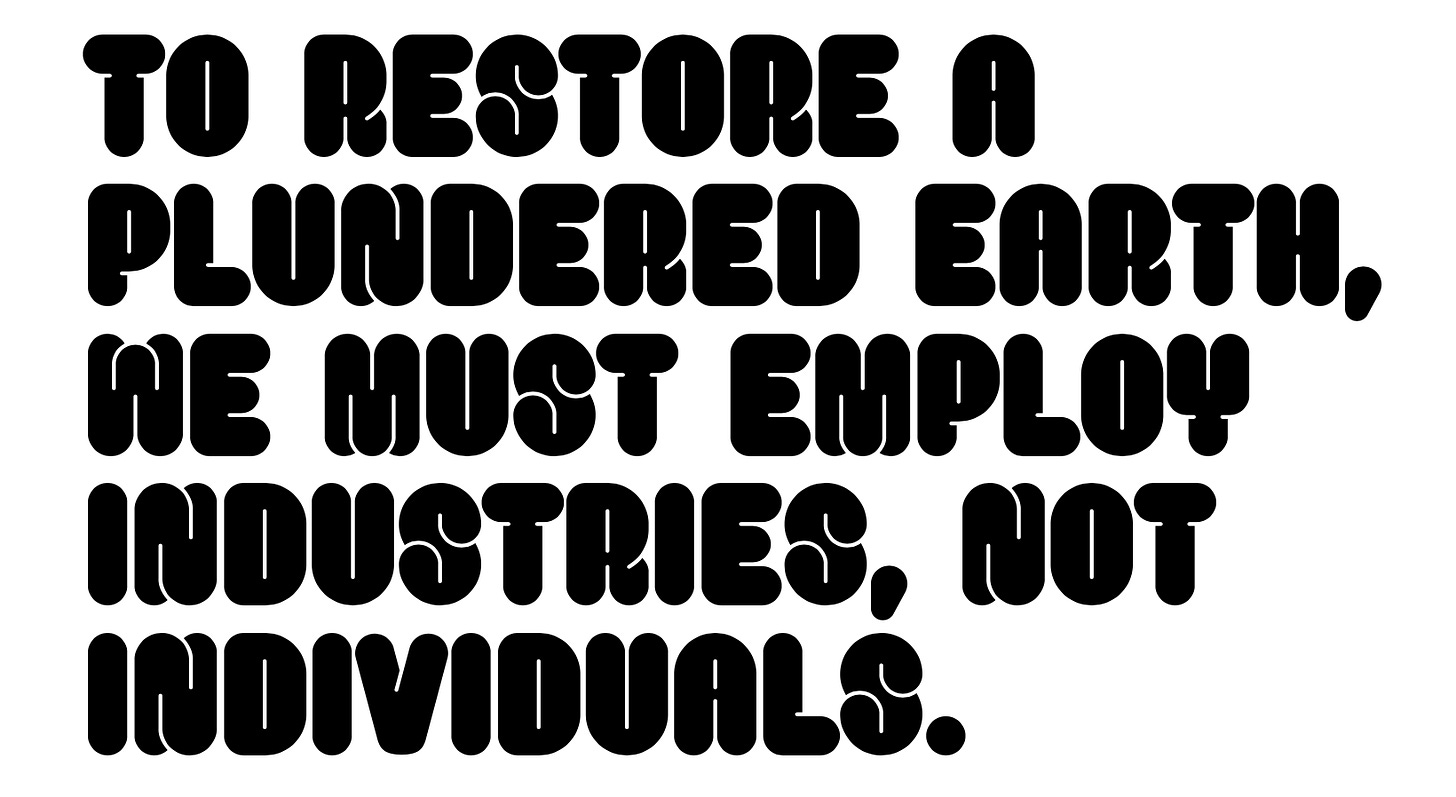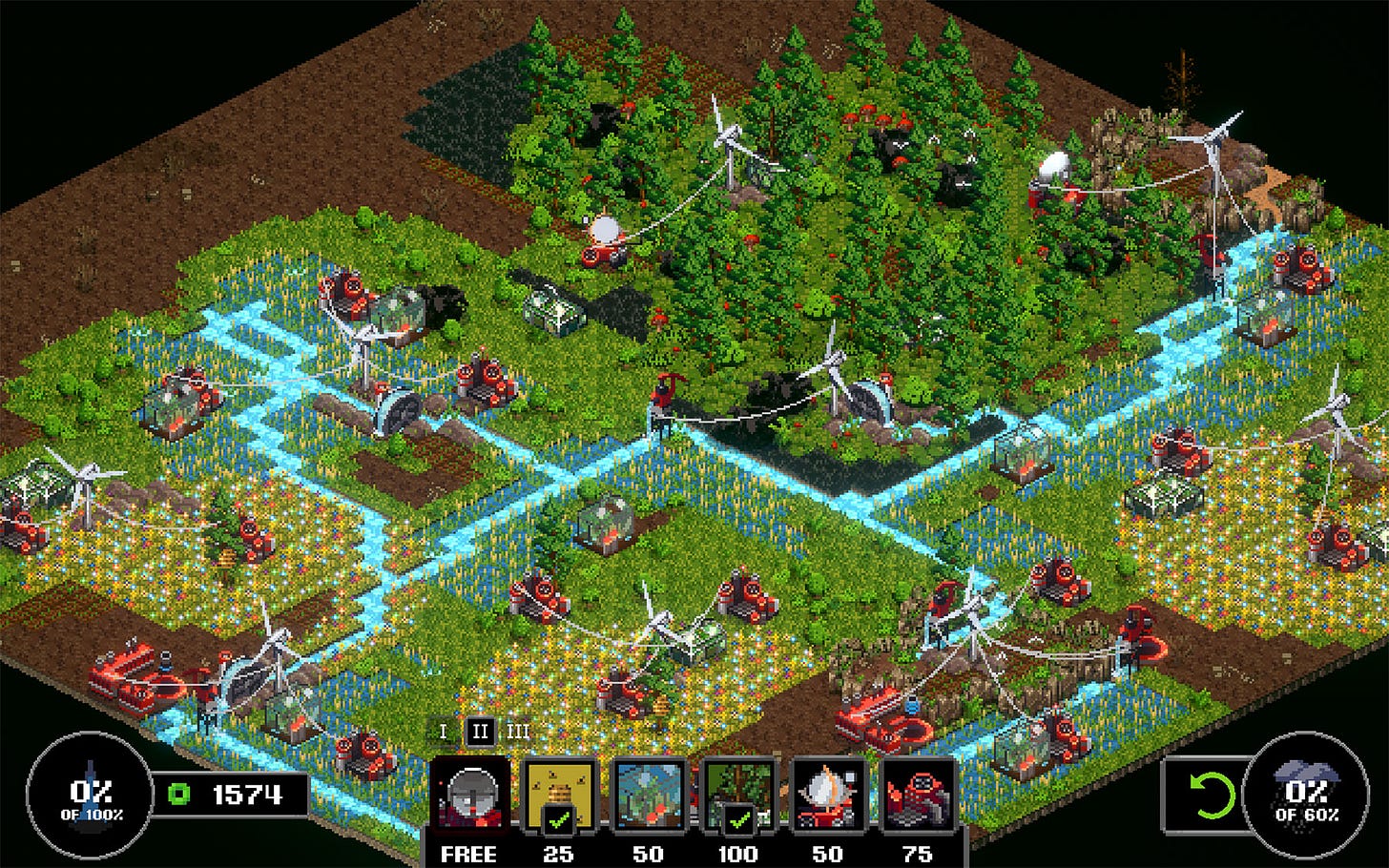Industries, Not Individuals Will Save the Earth
In Terra Nil, machines are the cure for a dying environment.
When the lockdown began in March, two unexpected things happened. I gathered news of the first on Twitter: the skies above Manila had cleared, people claimed. My boyfriend and I made for the rooftop that day, wanting to see it for ourselves. The sky did seem bluer than usual, and I swore that the mountain range I could see far to the north wasn’t there before.
Turns out much of the urban world was experiencing the same thing. The disappearance of cars, factory smoke, and most economic activity led to improved air quality, even for just a little while. In New Delhi, the difference between the city’s skyline before and after the lockdown almost seemed like divine intervention. Being witness to breathable, outdoor air while we were pinned inside our homes because of a killer virus seemed awfully like a cruel joke.
The second thing we didn’t expect happened right inside people’s homes. Perhaps in our bid to stave off the ennui of being stuck indoors, or perhaps to bring as much of the outdoors as we can inside, people collectively clung to the care and company of plants. Entire bedrooms, desktops, and condo balconies became lush with monsteras, philodendrons, pothos, and alocasias, all spoken of with as much love and knowledge as the average botanist. Unfortunately, a gray market of cuttings and potted plants followed overnight, causing bloated prices and prompting poachers to break into protected forests to make the most of the trend. Headlines called it a “plantdemic”, turning a harmless pastime into one more environmental crisis stacked on top of a 2020 defined by one bad news after another.
It seemed at one point that both these events had the potential to better our relationship with the environment. By a happy accident, we were shown what clean city air felt like, up until the government deemed the economy more vital than human lives and sent us back out, the machines of our livelihood polluting the atmosphere once more. In our frustration to be outside, we began a symbiotic relationship with our house plants, only for it to spawn a predatory market focused on profit over responsible propagation.
In both scenarios, it should be clear that individual people are not to blame. One person trying to eke out meaningful change has no power against the grinding gears of capitalism and big business—the forces that continually hold every material aspect of our lives in thrall. Time and time again, the outcry has been that an environmental crisis that exists now and until later generations cannot be solved at the grassroots level. From the time I’ve spent playing Terra Nil, an ecological sim game about reviving a barren land, it’s clear that the damages we have dealt the environment can only be undone with the same strength we used to build entire societies from scratch. To restore a plundered earth, we must employ industries, not individuals.

While Terra Nil calls itself a “reverse city-builder”, it shares the micromanagement mechanics of the genre it subverts. In order to revive the ecosystem, you must carefully lay down a network of structures, machines, and other pieces of tech all working in concert to stimulate the surrounding land. The game helps you manage this by doling out work in three phases: reintroduce vegetation, diversify its ecosystem, and, finally, remove all traces of human interference.
In your role as the green-thumbed director of this project, rejuvenating the earth is busywork. All infrastructures rely on clean electricity, which is generated exclusively by wind turbines that can only be built on top of calcified rock. Before greenhouses can be constructed, toxin scrubbers must be installed where you want vegetation to sprout. In areas too unstable for turbines to be erected, you need to pump enough water for calcifiers to strengthen the land and allow you to repeat the entire process.
Even with technologically advanced tools at your disposal, the game acknowledges and incorporates ancient practices of forest management as a means to diversify the ecosystem. In the comic “Prescribed Burn”, Xulin Wang tells the history of this practice—where indigenous folks of North America would periodically set parts of forests on fire to prevent larger blazes and encourage new growth—and how it was condemned by Europeans who came and colonized the continent. With their forests grown dense and littered by dead trees, dangerous seasonal wildfires became the norm. This year, California experienced a new wildfire classification: a “gigafire” that engulfed 1.03 million acres of land in flame and turned the sky across the West Coast orange.
In Terra Nil, controlled burn is rightfully institutionalized. After coaxing vegetation into the land, you are given the technology to administer a controlled burn in patches of fynbos, or converted shrublands. With machines in place to harness and redirect solar energy, ash from the resulting fire may then be used to nourish the soil and prep it for forest growth.
Before you move on to the final phase of the game, you are required to achieve a healthy level of biodiversity, where portions of the land are turned into arid plateaus, flowering plains, marshes, and dense woodlands. It’s a far cry from the endless tree planting projects that companies are wont to use as an easy prerequisite for their corporate social responsibility initiatives. An episode of 99% Invisible titled “For The Love of Peat” calls out the way we’re conditioned to see diverse, but less aesthetically pleasing habitats like wetlands as places in need of some tree planting intervention. True biodiversity, as demonstrated in Terra Nil, is achieved not when corporations use blanket environmental solutions like planting trees, but when funded organizations, government offices, and subject matter experts are called together to orchestrate large-scale, long-term, and ecologically suitable programs.
In classic city builders that I’ve played, like Zeus, the Anno series, and the fairly recent steampunk-themed Lethis: Path of Progress, the bustle of tiny people represents the lifeblood of a strapping society. Vendors circle the block with wares for the populace; cargo workers trundle about with loaded wheelbarrows; tax collectors make the rounds to fatten the city’s coffers. In Terra Nil, the deployment of big, expensive, and complex technology does all the work, suggesting powerful stakeholders working in the background. Without the need of a backstory, we know that this scenario, however bright-eyed and futuristic in its fiction, can only be possible with the generosity of corporations and the will of a government leading with foresight. The future posited by Terra Nil lies with powerful people in touch with the correlation between a global environmental crisis and the survival of ordinary people: the vendors, the cargo workers, and yes, even the tax collectors. If that time ever comes, we won’t have to cling to our plant cuttings or imagine those bygone days when Manila’s skies were at their bluest for a week.
Terra Nil is free to play on itch.io. The game is being redeveloped into a full commercial title with a new graphical style, improved levels, and deeper gameplay.
In the last two weeks, the Philippines was hit with some of the most powerful super typhoons ever recorded in human history. Entire towns and provinces sank in the water, leaving dozens dead and thousands displaced. The font I used in the above pull quote is Salbabida Sans by local type designer Jo Malinis, which you can purchase until the end of 2020 to help those affected by Typhoon Ulysses. You can also click the button below to see other efforts being made to help the victims of the typhoon.






Hi Miguel, I'm the lead artist on Terra Nil. I'm not sure if you're aware, but your writing this had quite a big effect on our art direction. I'd been pushing for more of a dichotomy between industrial destruction that ravaged the landscape and pre-industrial, Studio Ghibli-esque buildings that were used to heal the land. Your passionate argument that it was really important that these buildings look industrial was really powerful, and convinced me that showing that was really important. :)
I hope you're doing well, and thank you for playing the game and sharing your thoughts.